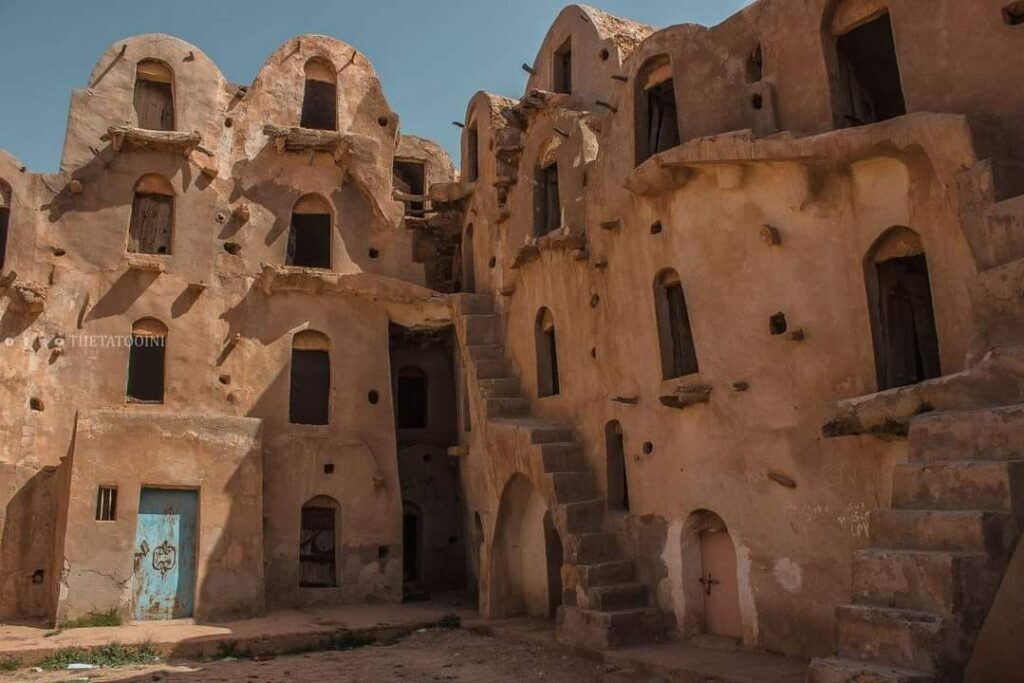Al-Zahra Palace
The Zahra Palace is located on the southeastern side of the city of Tataouine, 25 kilometers away from it, in the mayorate, which is currently known as the mayorate of Qasr al-Zahra, in reference to the palace, which was settled next to it by the descendants and children of its founders. The palace occupies a rectangular shape, especially on the southern and eastern sides, where it expands on this side and its edges are rounded, and the palace consists of two parts, an old part and a modern part separated by a shed, and the palace contains 314 rooms in both parts, and most of the palace rooms consist of more than five floors.
The old part of the palace
This part of the palace is older than the part that is located outside the palace entrance shed, and it occupies a square shape from the inside and consists of an olive wood-roofed shed topped by rooms in the form of an observation tower, and the shed leads to an open courtyard on which the palace rooms open one after another with all facades in the form of a chain, and the length of the palace rooms is between five or six meters and the width between 2.20 m and 2. 60 m.60 m. To connect the floors, staircases were designed between each of the two rooms, a common staircase leading to the upper floor, and the builder was wise in the distribution of staircases that lead to the upper floors, and the builder also left the corners of the palace free of rooms in the form of an interesting corridor separating the facades from each other in order to strengthen the cohesion of the building because the builder intended to connect the two neighboring facades with olive sticks in the form of arches to tighten the corners of the palace and this phenomenon we find it in Ouled Sultan Palace, which we talked about in the previous issue.
The Zahra Palace is characterized by an architectural phenomenon that distinguishes it from other palaces, as the upper rooms appear to the viewer in the form of runways, which suggests that the rooms of the second floor appear less tall than the room on which they were built, and the entrances to the rooms are about 0.90 m away from the entrance to the lower room. There is also an architectural feature that characterizes this palace that we did not find a trace of it in the old palace and other palaces, except for the palace of Awlad Sultan, which shares this architectural phenomenon, as between the room and the room on the ground floor there is a small room with a small entrance.
The old part of the palace is richly decorated with geometric and botanical motifs and Berber symbols and has a gypsum plaque with the name of the building and the year 1319, which researchers suggest could indicate the date of the founding of the palace.
The modern part of the palace
The modern part of the palace occupies a rectangular shape with an open courtyard to which the four-story palace rooms open, and the rooms of this part, like the rooms of the old part, are vaulted and of little width, and this part is newly founded and has three entrances on the eastern facade, an entrance in the southeast corner and an entrance in the southwest corner, and these entrances, according to archaeologist Ali Thabti in a statement to “30 Minutes” that they are modern and that the main entrance to this part is the entrance that is located on the eastern side The palace has witnessed various maintenance works, as a tank was created to conserve water for maintenance works in the modern part of the palace, and the solar stack was removed in all the domes of the upper rooms to maintain the rooms from rainwater leakage because the domes were about to collapse due to lack of maintenance and maintenance, then the solar stack was restored after cleaning the domes from old lime and strengthening the porcelain domes with plaster, as well as maintaining the stairs and upgrading some of them and restoring the external facades of the palace.
The palace is still owned by its owners, and several rooms have been used for trade, and one of the rooms has a butcher, and the palace square, especially the square of the added part, has been used as a weekly market, and the palace is also used for cultural activities such as summer festivals, especially the International Festival of Desert Palaces.
